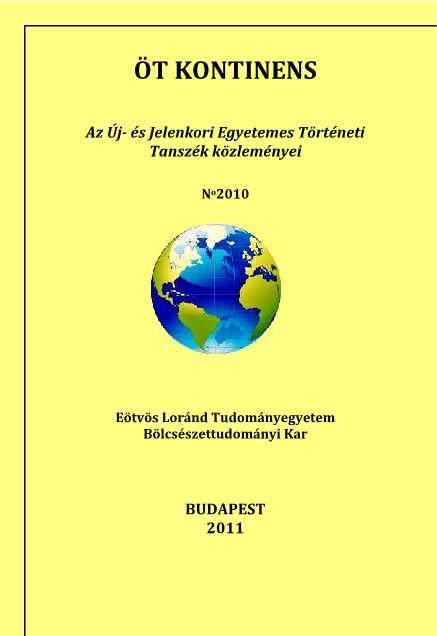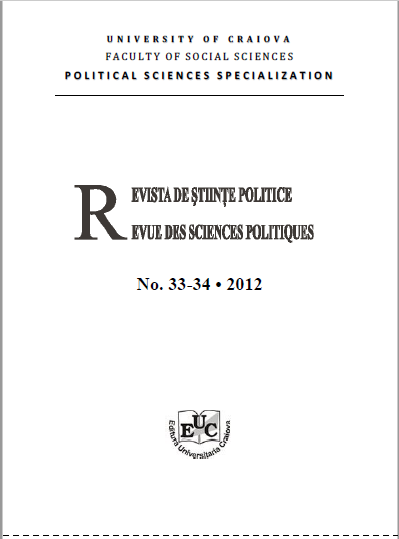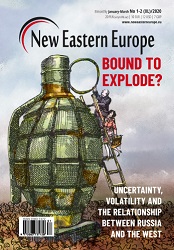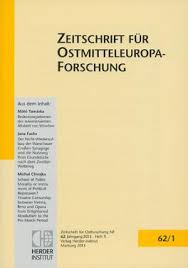
German rearmament in the Cold War
The author examines the question of the German rearmament during the Cold War. He presents this problem on the base of the Hungarian diplomatic sources and documents of the archives.
More...We kindly inform you that, as long as the subject affiliation of our 300.000+ articles is in progress, you might get unsufficient or no results on your third level or second level search. In this case, please broaden your search criteria.

The author examines the question of the German rearmament during the Cold War. He presents this problem on the base of the Hungarian diplomatic sources and documents of the archives.
More...
The study makes a research into the Paris Peace Treaty of 1947 and its links with the unfolding Cold War. The author considers both the negotiation phase as well as the conference phase of the Paris peace process, from late-1945 until late-1947, and analyses the whole peace process in the wider context of international diplomacy. The main conclusions of the study are the following: (i) the process of the Paris Peace Conference as a case study shows the actual process how the relations between the two superpowers, the US and the Soviet Union, derailed form a cooperative phase to an open hostility; (ii) during the Paris Peace Conference we can already observe many signs of both strategical and ideological distrust, which (iii) became visible right after the signing of the Paris Peace Treaty on February 10, 1947 thus contributing significantly to the long set of superpower conflicts that we mark as the early Cold War.
More...
This study presents the identity of Ceaușescu’s Communist Regime and its Image in the West. Furthermore, the author argues that after the collapse of communism in Eastern Europe, the most repeated words by the former communist countries were not ‘European Union integration’, but ‘European Union reunification’. In this context, it is important to note that after the revolution, Romania faced numerous difficulties on its way to democracy.
More...
When faced with an unknown situation or find themselves in un familiar field, politicians rely mainly on use of the analogies in decision making process. Guided by the logic of simplifying, they principally use historical analogies. The main purpose of such methodological en deavour is to perform better and get more comprehensive understand ing of a new issue. The main thesis of this paper is, first of all, failure of Serbian government to improve relations with United States through use of two specific historical analogies after 2000. It turned out that those analogies were inadequate and insufficient because of considera bly changed circumstances. The first analogy refers to Yugoslavia–US strategic partnership after the conflict between Tito and Stalin. The oth er one concerns the alliance of Serbia and US during World War I and efforts of Serbia to improve todayʼs bilateral relations in that manner. The importance of using these analogies is especially visible in Serbian exertions to gain kind of favour of US in the long process of dialogue between Belgrade and Pristina. The authors considered that both anal ogies were misinterpreted mainly because of transformed environment. Each historical epoch is unique. The second problem refers to diamet rically opposite narratives which are embedded in foreign policies of Serbia and US. According to the theoretical matrix of Timothy Snyder, these foreign policies rely on two contrasted logics: logic of inevitabil ity and logic of eternity. The possible solution lies in the shadow of the future, if we listen to Robert Axelrod. More precisely, we need to con tinue our cooperation because of good relations in the past and despite certain obstacles nowadays.
More...
Reloading and echoing a Biblical theme, modern industrial state, especially from libertarian view, has shown its capability of combining swords with ploughshares. The peril of modern centralised bureaucracy consists in chipping individual civic freedom for the sake of a small elite or state interests. One distinct view is the one of Murray Rothbard who argues that the growth of the modern national state has transformed intellectual independent labor in ideological propensity for its own sake. Focusing on America’s first part of the XX century, Rothbard considers that intellectuals (meaning a loose category encompassing a whole variety of subfield from mathematicians and school teachers to media pundits) have become a techno-priesthood forging a new alliance between Throne and Altar. Using Murray Rothbard’s theoretical framework, this study analyses RAND Corporation as a case of science embedding in service of political power.
More...
The Ribbentrop-Molotov Pact has represented, until today, a reference topic in the analyses of those who study history and international relations. From the Romanian point of view, the Molotov-Ribbentrop Pact achieved the master stroke to the system of alliances built by Romania in the interwar period. In fact, the German-Soviet agreement eliminated the Franco-British presence in South-eastern Europe, the European equilibrium was destroyed and its reconstruction in favour of Romania was almost impossible in the new geopolitical and geostrategic situation.
More...
The article is based on the analysis of literature and narrative sources, including those recorded in personal conversations. On the example of T. M. Zakharova the author shows the realization of “soft power” notion. T. Zacharova combined work at the Leningrad plant of laminated plastics with public diplomacy; she was vice-president of the USSR — USA Friendship Society, a member of the Committee of Soviet Women, a board member of the Leningrad branch of the Union of Soviet Societies of Friendship and Cultural Relations with Foreign Countries. Fate and international activity of Zakharova is considered in the article as the influence of a personal factor on public diplomacy practice. The example of T. M. Zakharova testifies that women at international conferences and meetings related to issues of peace and disarmament. The article cites facts connected with her ability to find convincing arguments and effective forms of explaining the policy of the Soviet Union during the Cold War. T. Zacharova managed to find such arguments and explanations in difficult situations in the course of communication with representatives of foreign countries. Her job as a representative of public diplomacy was appreciated. She was awarded the Soviet Order of Friendship of Peoples and the Sign “Influential Woman of the World” by the United States Women’s Public Organization. The article analyzes the activity of T. M. Zakharova, and it is shown that she was a typical Soviet-era nominee for party, state and economic positions chosen on socio-party-demographic criteria. However, her personal qualities did contribute a lot to her efficiency as a representative of “soft power” in diplomacy.
More...
It is no exaggeration to describe the 20th century as the century of the big hydraulic infrastructures. Notably, the number of large dams has proliferated during the period between 1950-80 that corresponds to the Cold War era. This study seeks to analyze the relationship among the Cold War, the large hydraulic works and the transboundary water relations. Gathering empirical evidence from the different transboundary water basins, this study argues that the Cold War influenced large hydraulic works and transboundary water relations in two ways. On the one hand, the Cold War era constituted a conducive political environment for the proliferation of large hydraulic works, and henceforth, it has strongly affected transboundary hydropolitical dynamics. On the other hand, the Cold War has conditioned the regional contexts in which transboundary water relations take place. Finally, the paper also finds that even though the motivation to build large hydraulic works, which is the legacy of the Cold War era, appears to slow down in the developed countries, it is still intact in the developing countries.
More...
In the newly shaped post‑WWI Europe the CEE region was an integral part of the pan‑European media system. The iron curtain that split Europe into two parts in the bipolar period, inevitably led to the emergence of two separate media systems, i.e. the Western European one and the one driven by the USSR (and existing predominantly in Eastern‑European states). These systems were institutionalized by the establishment of separate broadcasting alliances and corresponding TV programme exchange networks. At the same time, in the context of the Cold War, the CEE region was a key target of Western broadcasting with the aim to counter Soviet propaganda and political influence. This factor reinforced by the willingness of the CEE countries to preserve their European identity caused the socialist media system (as well as other Soviet integration projects) to remain artificial and to be rejected in the region. It was clearly confirmed at the beginning of the post‑bipolar period, when, after the collapse of the socialist camp and the USSR, the Soviet‑driven International Radio and Television Organization ceased to exist, and the CEE countries integrated into the European Broadcasting Union, unleashing their desire to “return to Europe”. At the same time, in the context of a policy aimed at preserving control over the post‑Soviet space, Russia makes efforts which could be regarded as an attempt to restore (preserve) the common media space in the post‑Soviet territories. In the paper the CEE region is regarded in the broadest way, including all states which were in socialist bloc, and appropriate former European Soviet republics.
More...
During the Cold War, the superpowers used their ideologies as symbolic capital in the struggle for new spheres of influence. The United States emphasized slogans of freedom and democratic values, and the USSR propagated ideas of socialism. One of the key “messages” exploited by Soviet cultural diplomacy in the post-war world was the image of the October Revolution as a benchmark for the struggle for a just socialist system. The ideas of Great October were most intensively vocalized and reinterpreted during round-number anniversaries. In 1947, officially celebrated for the first time not only in the Soviet Union, the thirtieth anniversary of the October Revolution had witnessed the initial efforts of the USSR to sovietize Central and Eastern European countries’ cultures and ideologies. By exploring this case, the article surveys the mechanisms and ways the Soviet festive activities and rituals were implanted and adjusted to foreign surroundings. Jubilee celebrations are taken here as part of commemorative practices aimed at developing a “socialist” identity in Central and Eastern Europe and their further integration into the Soviet cultural and political space of influence. Reconstructing the general mode of the holiday and the specifics of its functioning in different countries, the article concludes that, in many respects, the first “common” commemoration of the October Revolution abroad represented a “transitional” stage where Soviet ideological messages were relatively fuzzy and imposed rituals had to be variably adjusted to Eastern European social environments.
More...
During the Cold War, Berlin was the place where the rivalry between the Soviets and the Western allies was felt most intensively. The Berlin Wall is an iconic structure of the Soviet Union, who built it in order not to fall behind in this rivalry. The wall stood physically intact for 28 years, between 1961 and 1989. The impact of the Wall on the political, economic and social life of Germany remains the same even after 30 years of its fall. The inability to remove the walls in the German social memory and the inability to overcome economic disparity make the former East Germans feel like second-class citizens. Even though Germany is geographically united after the Berlin Wall, it needs time to complete its social integration.
More...
This is a review of the book "Cold War Through Documents. A Global History", Third Edition, Edited by Edward H. Judge and John W. Langdon, Lanham, Boulder: Rowman and Littlefield, 2018, 366 p.
More...
The present article attempts to analyze the case of Vietnam as a middle power caught in-between two potentially inimical greater states, viz. the United States of America and the People’s Republic of China, in the aftermath of the Cold War, with a view to exploring the degree to which the former would have managed to maintain its relative independence in respect of each of the contending powers while drawing benefits from the relations with either of them.Making use of the multiple sources covering the presentday relations of Vietnam with both China and the U.S., the author argues that even though Vietnam had been confronted with several critical junctures wherein it may be motivated to fully align with either of the two powers, the country’s leadership would maintain a relatively neutral position while participating in the structures of interdependence and integration involving both great powers under consideration. Several implications for Ukraine’s international political strategy are thus foreshadowed in that respect.
More...
The easing of the Romanian-American strained relations took place gradually, especially after the acceptance given by Americans for Romania’s admission to the UN (1955). At the initiative of Moscow, the eastern states opened new channels of communication and collaboration with the West in the 1950s, with the desire to gain access to trade and new technologies. Between 1956−1960, the Romanians were gradually accepted to congresses and scientific specializations in the US. During this time period, American journalists, congressmen and culture people visited Romania, building step by step more hassle-free relations between people and institutions. As a result of these good relations, in 1961, the visit of an important Romanian economic legation to the US took place. Romanian specialists have gained access to the “secrets” of American agri-culture and industry, have managed to get in touch with large US companies and to see on the spot, live, the application of new working protocols in agriculture. The experience and knowledge gained helped the Romanians to return to the country with a big plus, which meant an important contribution to the economic modernization of Romania. Moving towards Western technologies, the closeness they achieved with the Americans while trying to gain access to the top achievements of the US economy, was in fact the Romanian response to the harassment made by Khrushchev, for years, to the “younger brother” of the Balkans. Besides, the very good reception that the Romanians felt in the United States was due to Bucharest’s restriction towards some actions of the USSR and the emphasis of the autonomous character of Romania, within the Eastern Bloc.
More...
The Romanian-Polish relations of the last decade of communism were largely studied either at the beginning of the ’80s when Solidarity Movement emerged or at the end of the ’80s when semi-free elections took place in Poland and Mazowiecki’s government was established and the period from 1982 to 1988 was insufficient researched. Moreover, the complicated international context drew the attention from the introduction of martial law in Poland to the new conflict between the Soviet Union and the US. Because of that, in my paper, I will examine the bilateral relations between Romania and Poland and how the new regime from Warsaw affected them. For achieving that, I will use the diplomatic correspondence of the Romanian ambassador from Warsaw and also the Romanian Communist Party (RCP) archives. In the case of RCP archives, I will focus primarily on the debates from Politburo concerning the evolution/involution of bilateral relations. At the same time, I will look to the remarks made by leaders or politicians in the newspapers to comprehend how the relations were officially presented to the people. From the diplomatic correspondence, I used especially the telegrams and reports sent by the Romanian ambassador to understand how it was described the domestic evolution in Poland and whence it reflected toward the Romanian-Polish cooperation. In the end, the corroboration of these sources will give us a comprehensive picture of Romanian-Polish relationships at the beginning of Jaruzelski’s regime. Although it is from a Romanian viewpoint, I used several sources, alike RCP’ archives, the Romanian Ministry of Foreign archives and newspapers, for creating a more balanced perspective.
More...
Werner Herzog’s documentary Meeting Gorbachev seems to be a cinematic expression of the West’s love of Mikhail Gorbachev. And if there is one central theme to the film, it is Gorbachev shunning responsibility for his failures one after another.
More...
Review of: Christopher A. Molnar - East Central European Migrations during the Cold War. A Handbook. Hrsg. von Anna Mazurkiewicz. De Gruyter Oldenbourg. Berlin – Boston 2019. 465 S., Ill., graph. Darst. ISBN 978-3-11-060753-6. (€ 129,94.)
More...
Review of: Behind the Iron Curtain. Soviet Estonia in the Era of the Cold War. Hrsg. von Tõnu Tannberg. (Tartu Historical Studies, Bd. 5.) Peter Lang Edition. Frankfurt am Main 2015. 429 S. ISBN 978-3-631-66849-8. (€ 76,95.) Reviewed by Bradley Woodworth.
More...
Review of: Joanna Wojdon: White and Red Umbrella. The Polish American Congress in the Cold War Era 1944-1988. Helena History Press. Budapest 2015. IX, 360 S., Ill. ISBN 978-1- 943596-00-3. (€ 38,–.). Reviewed by Sophie Straube.
More...
Review of: Patryk Babiracki: Soviet Soft Power in Poland. Culture and the Making of Stalin’s New Empire, 1943-1957. (The New Cold War History.) University of North Caroline Press. Chapel Hill 2015. XV, 344 S., Ill., Tab. ISBN 978-1-4696-2089-3. ($ 37,50.). Reviewed by Oleg Garms.
More...